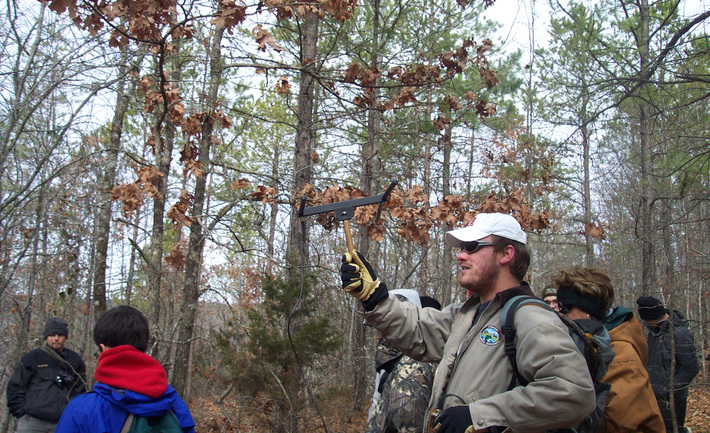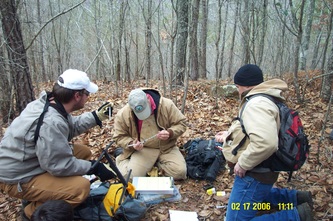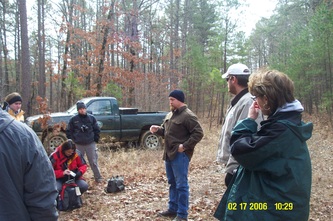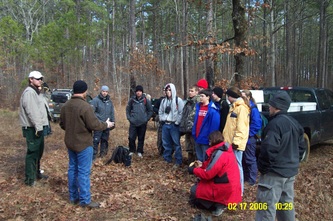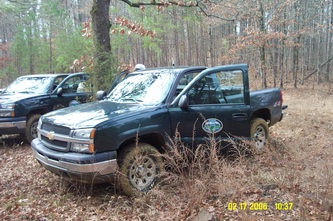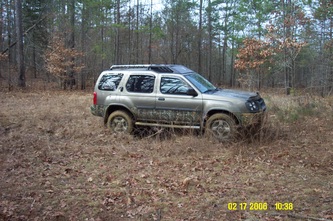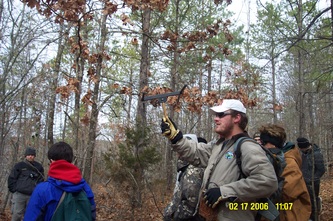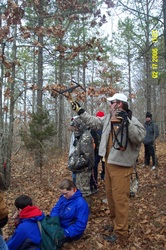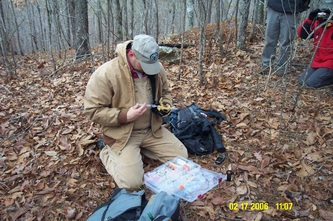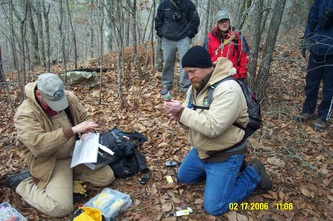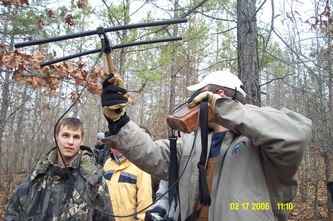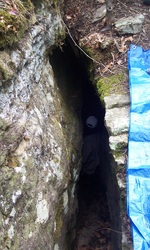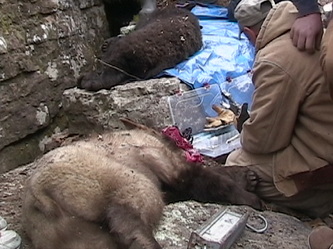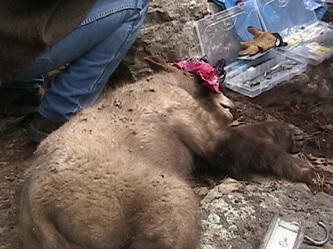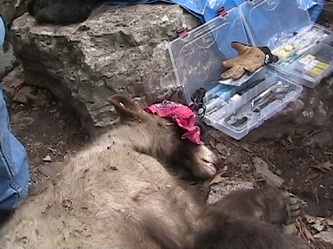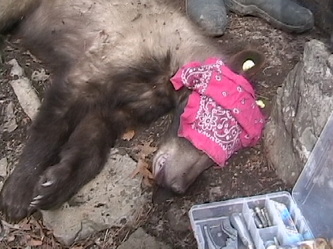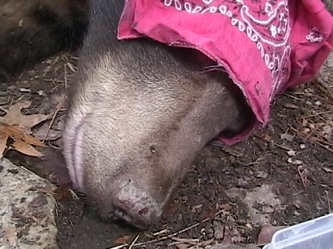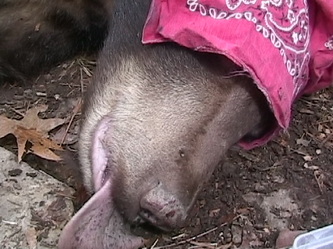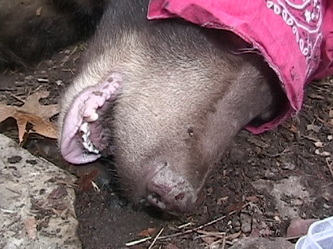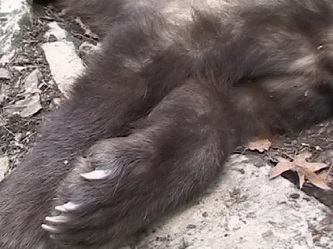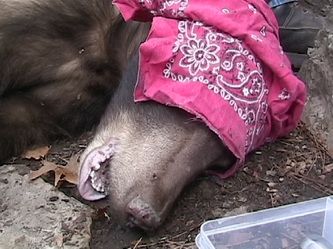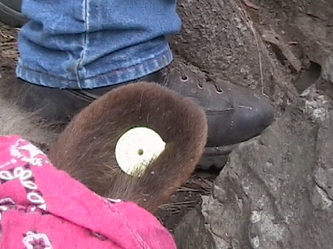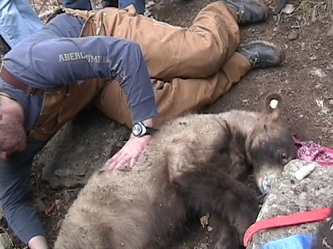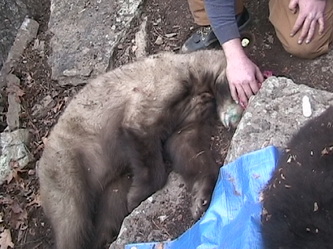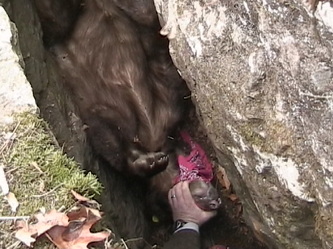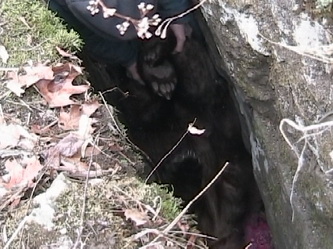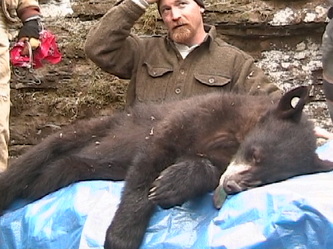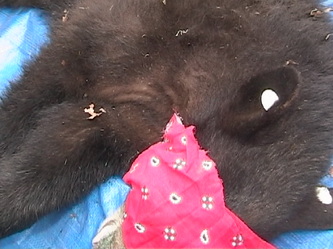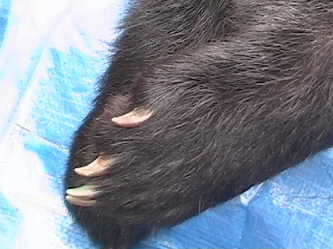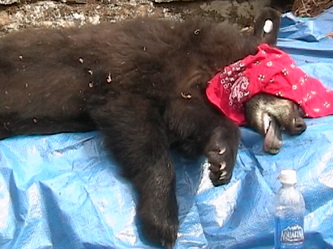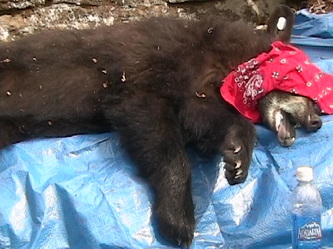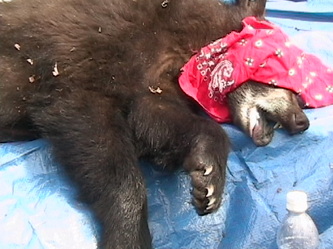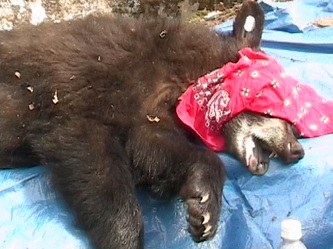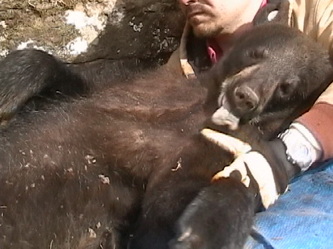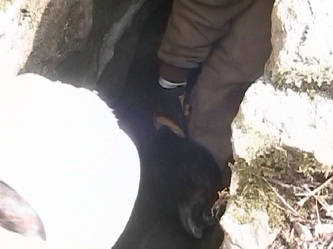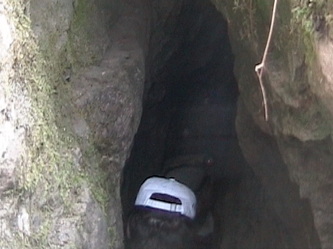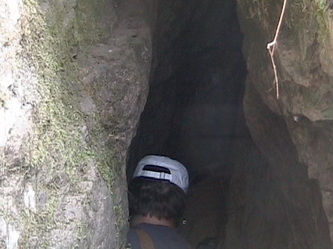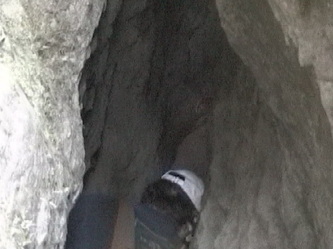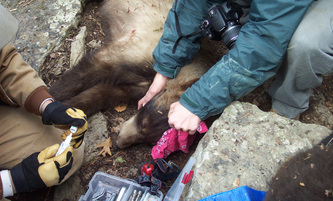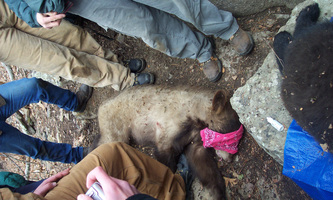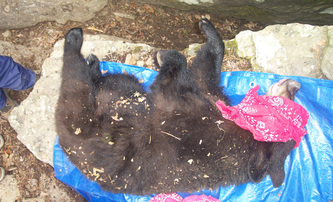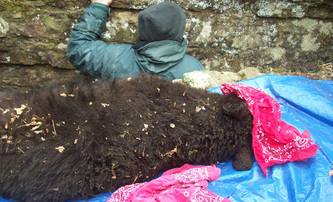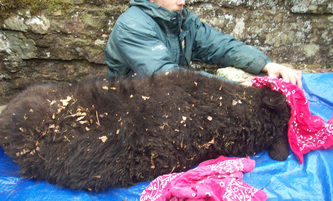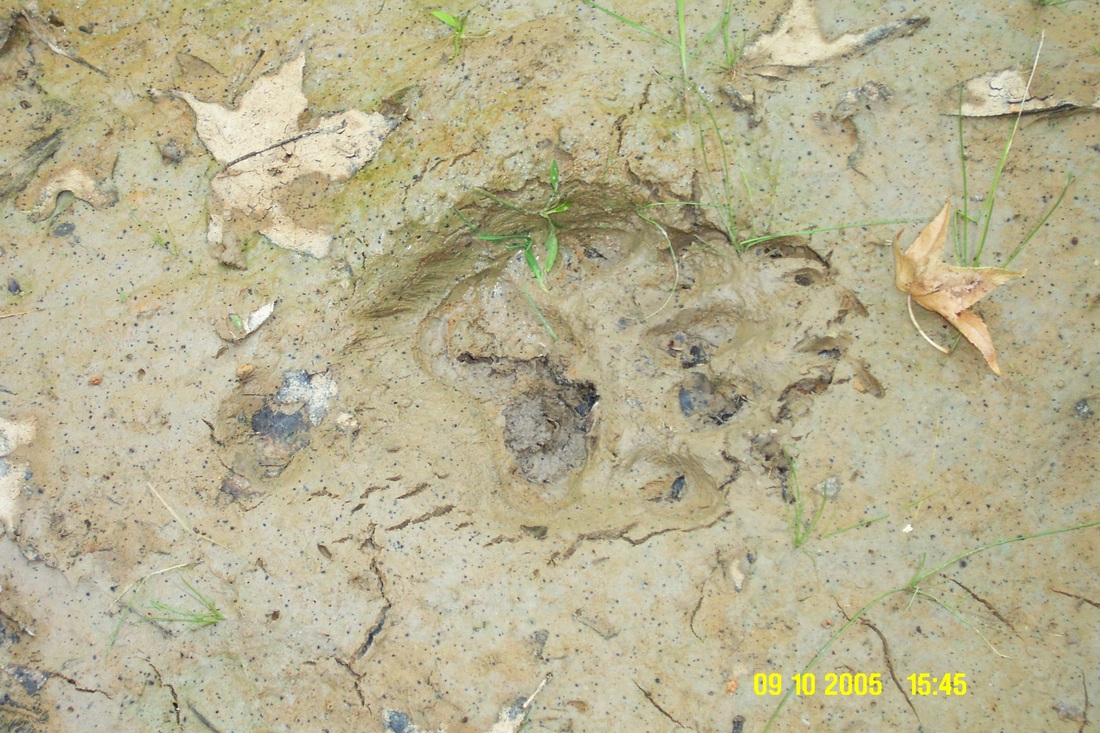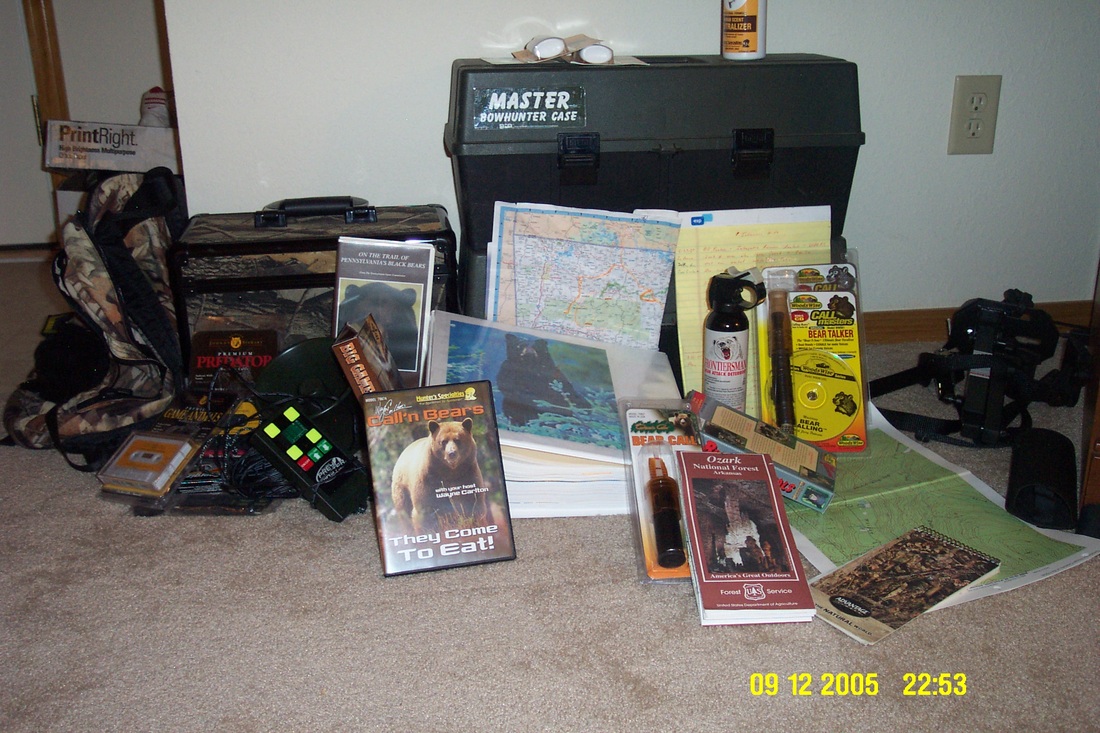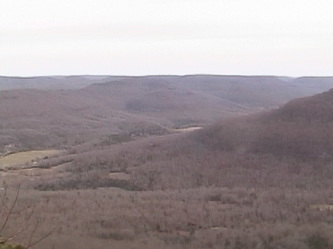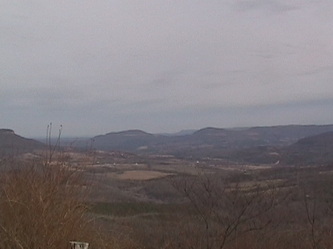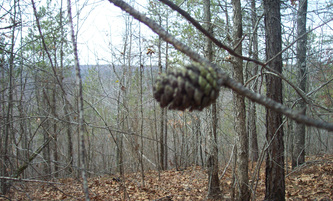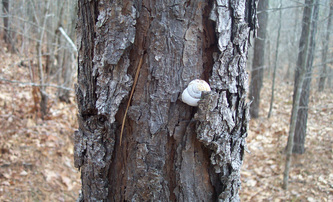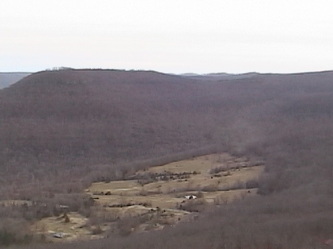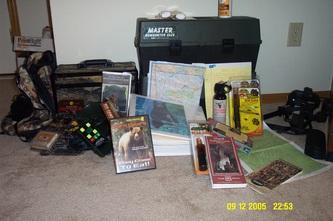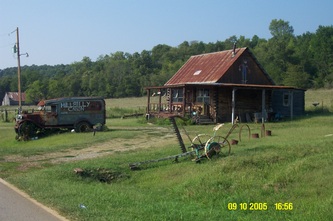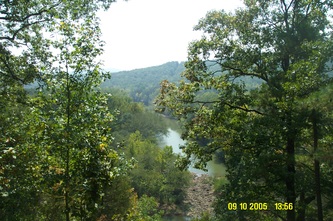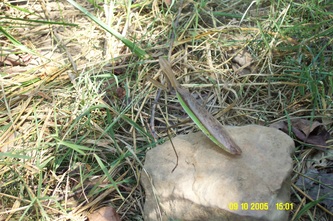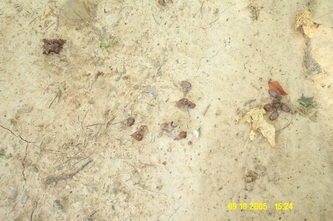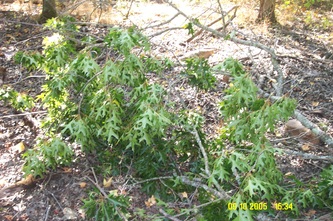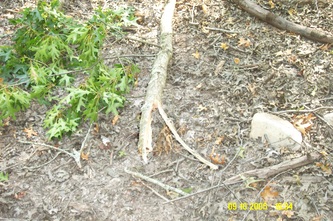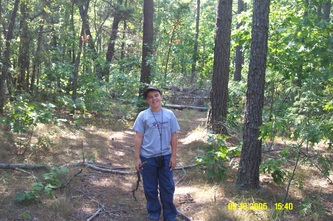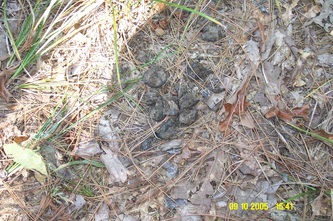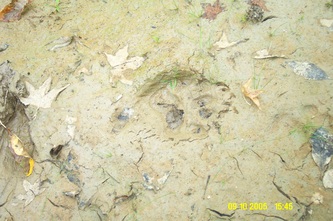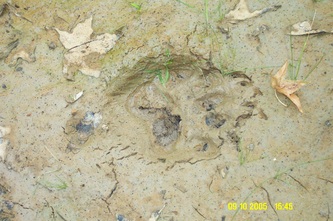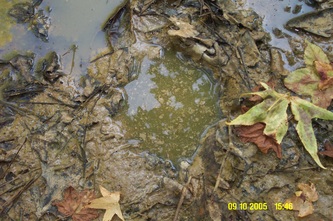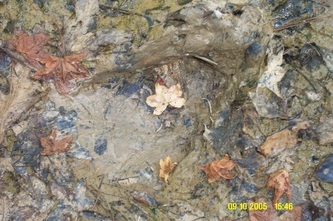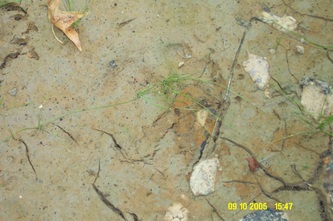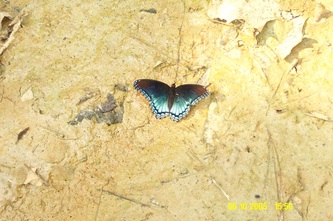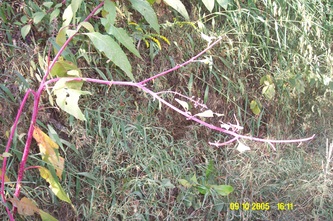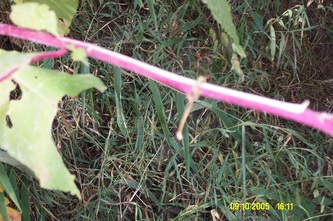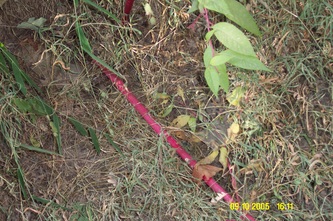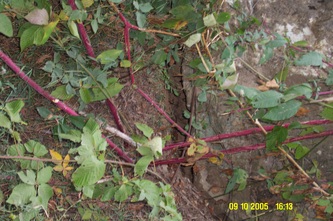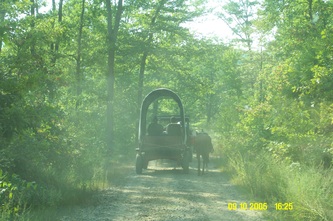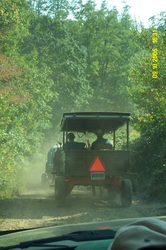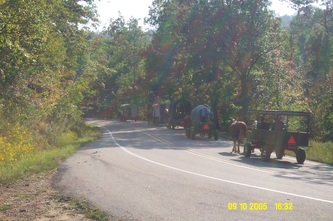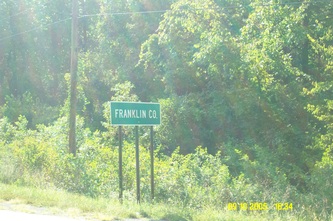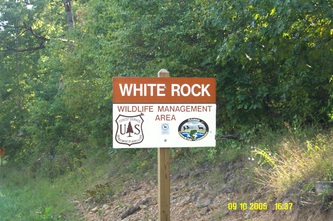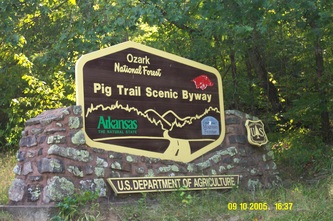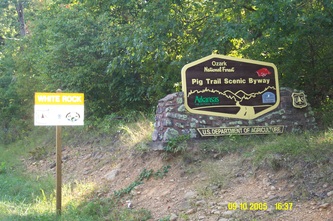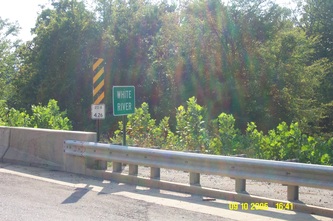Feburary 17th 2006 Bear Denning
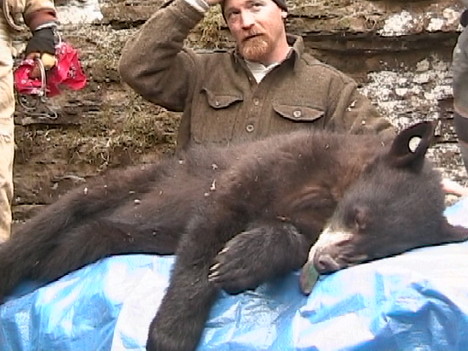
Arkansas Bear Noodling
After working with the Arkansas Game and Fish Commission throughout 2005 doing research on black bear hunting in Arkansas they gave me a call an invited me to go Arkansas Bear Denning what I like to call Bear Noodling.
Now the Arkansas Bear Biologist I believe is some of the best in the country when it comes to bear management and what it takes. Also with all that in mind they have to be just a little crazy for what they go thru to get the bears out of the den.
In this case they had capture the female in the early fall and collared her. Then in February they follow the transmitter to the den and then crawl inside to tranquilize the Mother bear and cubs.
Now remember bears in Arkansas are not exactly asleep and the ole sow is just to happy with a human in the den with her. But it is necessary so that the cubs don’t run out of the den and get separated from her this time of year.
After working with the Arkansas Game and Fish Commission throughout 2005 doing research on black bear hunting in Arkansas they gave me a call an invited me to go Arkansas Bear Denning what I like to call Bear Noodling.
Now the Arkansas Bear Biologist I believe is some of the best in the country when it comes to bear management and what it takes. Also with all that in mind they have to be just a little crazy for what they go thru to get the bears out of the den.
In this case they had capture the female in the early fall and collared her. Then in February they follow the transmitter to the den and then crawl inside to tranquilize the Mother bear and cubs.
Now remember bears in Arkansas are not exactly asleep and the ole sow is just to happy with a human in the den with her. But it is necessary so that the cubs don’t run out of the den and get separated from her this time of year.
CRACK IN ROCK or DEN
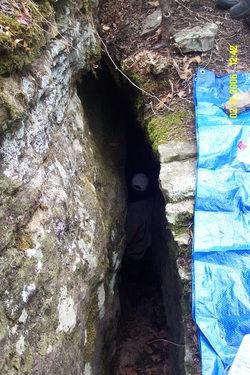
What looks like a crack in rock formed by an Oak tree root is actually a DEN, What you are seeing is one biologist that is over 6 foot tall below me then another, biologist below him then yes one more biologist below him. This goes way into the rock.
The female was too big to pull out of den on this trip but the Male Blonde Cub was 110 lbs and the Black Female Cub was a 105 lbs. When grabbing the cub you had to be sure that your hand stayed away from the mouth because they still had bite reflex. Also they may look like they are soft and furry but it was like hugging a tree, no give what so ever, solid muscle.
They tell me typical cubs are not this big but they had a big acorn crop this year so the cubs they are tagging are very healthy.
Very little thing in my life as a hunter has ever made such an impression on me, for me this was a once in a lifetime chance and gave me such appreciation as a hunter for the bear and bear management and how outstanding of a job Arkansas Bear Biologist do for the bear.
The female was too big to pull out of den on this trip but the Male Blonde Cub was 110 lbs and the Black Female Cub was a 105 lbs. When grabbing the cub you had to be sure that your hand stayed away from the mouth because they still had bite reflex. Also they may look like they are soft and furry but it was like hugging a tree, no give what so ever, solid muscle.
They tell me typical cubs are not this big but they had a big acorn crop this year so the cubs they are tagging are very healthy.
Very little thing in my life as a hunter has ever made such an impression on me, for me this was a once in a lifetime chance and gave me such appreciation as a hunter for the bear and bear management and how outstanding of a job Arkansas Bear Biologist do for the bear.
Getting ready and Finding the Sow and Cubs inside the Den.
Get in, Get Cubs Out, Get Tagged, and Get them back in.
BEAR HUNTING SUMMARY – 2005 ARKANSAS
Before I went bear denning with the Arkansas Game and Fish I went bear hunting and had a great time, got close but never got to see a bear while hunting on public land.
ARKANSAS GAME AND FISH REGULATIONS in 2005 had Zones and in Zone 1 hunter could only take 200 bears. Zone One is in the Northwest part of Arkansas, Archery Season which is what I decide how I wanted to hunt my first black bear was – October 1st, 2005 thru November 30th.
They did have other season Muzzleloader, Modern Gun and Youth Season. Either way you had to call 800 number which was in their Regulation Booklet the evening before to check the quota to see if zone still open.
After killing bear and before moving it you had to fill out game tag on Page 33 of Arkansas Hunting Guidebook and call within 24 hours to 800 number in Guidebook
Also you had to extract premolar tooth for the Arkansas Game and Fish so they could keep their data and research up.
The biggest thing to overcome while hunting on public ground but I understand why. No baiting allowed on public land, since it is public land other activities are going on and baiting could cause unattended issue. Same went for using scents. Really baiting is the only way you are going to have a chance at a black bear in this part of the country.
Calling and Electronic Calling allowed are allowed but for me it did not produce any bears, but I would say that it would work just fine if I did see a bear off in the distance. Matter fact I believe it would be very intense style of hunting since, you are basically calling the bear to come eat.
HARVEST DATA
2004 – Bear harvest 340 – 183 males & 157 females – Zone 1 – 203 checked in and hunt was closed Nov 13th. 166 Bears taken by bow, 82 muzzleloader, 92 modern gun. Private land 124 bears taken using bait.
Johnson, Pope, Newton, and Searcy counties are some of the top counties in Arkansas.
When trapping in the early fall they had individual bait stations which are established at .5 mile intervals on established routes within bear country. Johnson County (1992)
Location within in Arkansas was listed as No. 1 Complaint “Livestock Feed – 1998”
The No.1 months for these complaints are in August and September just before the Acorn Drop.
MAPS & POINT OF INTEREST
White Rock – 280,000 Acre within the Ozark National Forest was a large track of land.
Cass, Arkansas – Franklin County, Johnson County, Newton County, Pope County again was some of the top harvest.
Within the Boston Mountain Ranger District - Mulberry River noted by individuals canoeing note bear sightings.
Piney Creeks Wildlife Management Area 176,00 Acres was another public hunting area.
Ozark National Forest
Richland Creek another source of water.
White Rock Mountain Recreation Area
Gas Well, Pipe Line on Alexander Mtn was good area for clearning.
But my choice was Morgan Mountain – Ponds – 3 miles from Johnson County
4 – Ponds – 2 dry, 1 wet, 1 not found. Spy Rock Hollow and Branch off of Herrods Creek
94669D – Turn Left and Logging and New Road. Fly Gap comes out to Morgan Mountain Cemetery
Outside of my hunting area of interest
Dry Creek Wilderness, Ouachita National Forest – One of the largest populations of black bears in Arkansas reside here. (Density)
White Rock and Dry Creek Study Areas.
White Rock and Cass area boundaries of study area.
White Rock was one of the original bear reintroduction sites.
Traps located on ridgetops 160 yards from roads.
Not hunting this area (White river currently trapping bears and re-population of other areas.)(Big Island owned by Anderson-Tully Company and Montgomery Island Hunting Club)
One release site was the Muddy Creek WMA in Ouachita National Forest
Currently bear densities in some areas are as high as one bear per 2 square miles and overall may be as high as one bear per four square miles.
At one time Arkansas had the largest populations in North America and the White river still held 40 to 50 when population was at its lowest.
Two release sites at the time of reintroduction were Piney Creek Wildlife Management Area and White Rock Wildlife Management Area.(Black Mountain)
White Rock is known as success because of high density of bears.
3.5 year old male Black Bear was marked near Cass.
Dens location majority are rock bluff dens.
West of 23 – CASS – Soda Hollow & Browder Hollow
East of 23 – Redding Campground – Herrod Creek, Indian Creek, Mountain Creek
White Oaks will be EAST side of Morgan Mountain and are the preferred food source. Broken Branches on white oak tree are good way to track bears – Follow fresh to old branches.
Newton County – Stack Rock was another notable site.
BIOLOGY AND HABITS
Bears have poor eyesight and have an extraordinary sense of smell.
Adult Males – 130 to 300 pounds
Adult Females – 90 to 150 pounds
Biggest bear documented is 600 pounds
Male and Females cannot distinguish between.
Males are larger.
Older Bears short legs, looks closer to the ground and grove in middle of forehead and short eared.
Younger bear’s have longer legs, longer ears
Body growth among highest in North America
Infanticide by adult male black bears will occur.
Because of the reintroduction of bears was close to the same percentage 23 percent of the Bear now in Arkansas are brown or cinnamon in color in the Ozark Mountain Region.
Bear will stand on its hind legs with its nose in the air to scent the wind.
FOOD FOR BEARS
Will dig for roots and rip open logs and stumps for food.
Black bears are rarely vocal, but do have several calls.
Growls and huffs – anger
whining and sniffs
woof – woof- woof – female warning cubs
The cry of a bear cub is similar to that of a human baby.
Bears will eat almost anything.
Soft mass and hard mast in the fall. Acorns and Berries
Weight gain of 1 to 2 pounds per day.
Low human activity – active dawn till dark.
Acorns 34% of diet.
Pokeweed in October
Oak Mast most important
20000 calories in a 24-hour period while feeding on acorns
Bear movements increase in response to acorn abundance, known as the fall shuffle. Their Activity patterns change from being primarily crepuscular (Crepuscular is a term used to describe animals that are primarily active during the twilight. Crepuscular is thus in contrast with diurnal and nocturnal. Crepuscular animals may also be active on a bright moonlit night. Many animals that are casually described as nocturnal are in fact crepuscular. Within the definition of crepuscular are the terms matutinal and vespertine, denoting animals active in the morning (dawn) and evening (dusk) respectively), to nearly continuous activity to forage on acorns.
Localized mast resulting in increased effectiveness of archery hunters.
Black bears consume whole and prefer white oaks.
Look for White Oak that are 50 years and older but less than 120 years they tend to produce the most and best acorns.
Pokeweed requires clearings.
Paw prints in the mud or sand, Bear Scat, Turned over rocks. Claw marks on tree trunks are communication between bears – 3 to 6 feet off of ground are all the different ways to track a black bear in area it uses.
BEARS DRINK FREQUENTLY AND ARE USUALLY FOUND IN THE VICINITY OF WATER. Water source in dry areas are. Are some of the best location to find bears.
Home ranges of adults are 5 to 20 square miles. August, September and October feed 18-20 hours a day.
Calling usually brings in larger bears.
Bear can hear a call up to mile depending on terrain.
White Oak Benches are also great places to find bears.
SURPRISE ENCOUNTERS
Few things I needed to know before going out was stand your ground. Shouting and Bear Spray
HUNTING
Where to aim – Broadside by following the line up the center of the nearside leg to a point 1/3 to ½ up on the chest. Wait for near side leg to move forward. Hunting without bait methods look for main food source – Hilltop ridges with white oak acorns. Clear Cuts from early spring or summer that will have pokeweed also great places.
Varmit Calling if a bear is sighted in the distance.
Harvest records for the first 6 bear hunts note Newton and Franklin Counties in 2005.
Outcropping of rock ledges and rock benches (Area on tops that lines are almost together or touching).
Hunter bag all four of his bears between 12:00 p.m. and 4:00 p.m.
If you do have a down bear always approach down bear from uphill. Also a dead bears eyes should be open.
Predator Call – Never quit calling until ready to shoot.
Note in Arkansas White Tags are Female and sometimes have radio collars they are legal but a lot of research goes into them
Yellow Tags are Male and sometimes are two yellow tags nuisance bears.
REFERENCES TO LOOK FOR
Wanting to learn more about bears these are some great resources.
Joseph D Clark – Ecology of Two Populations in the Interior Highlands of Arkansas
(Now at the University of Tennessee) – White Rock and Dry Creek Study Areas.
Fall Food of Black Bears in Arkansas
Joseph D Clark
Oak-Black Bear Relationships in Southeastern uplands
Joseph D Clark
E-MAILS & INTERVIEWS
Ricky J Eastridge – Biologist AGFC – Phone and E-mails
Joseph D Clark – E-mails
Rachel Spaulding – AGFC - E-mails
Mike Capps – Hunter Specialties – E-mails
Wayne Carlton – Carlton Calls – Phone
Jerry Peterson – Wood Wise Calls – E-mails
Bill Paxton – Integrated Resource Analyst – USDA – F.S. – In Person
Ralph Odegard – Wildlife Biologist – USDA F.S. - Phone
Rhea Rylee – District Biologist – Boston Mountain Ranger District – Phone
Myron Means – AGFC – Field Biologist - Phone
Mike Mulford – Forest Service – In Person
Hunter & Loggers in Person.
MISC.
Be prepared for a difficult drag, since hunting by myself will need winch and sled. Bear meat is similar to pork I am told.
Taxidermy Estimates run Full Mount – $1,800, Half – $750, Rug – $750 or Shoulder – $350
ARKANSAS GAME AND FISH REGULATIONS in 2005 had Zones and in Zone 1 hunter could only take 200 bears. Zone One is in the Northwest part of Arkansas, Archery Season which is what I decide how I wanted to hunt my first black bear was – October 1st, 2005 thru November 30th.
They did have other season Muzzleloader, Modern Gun and Youth Season. Either way you had to call 800 number which was in their Regulation Booklet the evening before to check the quota to see if zone still open.
After killing bear and before moving it you had to fill out game tag on Page 33 of Arkansas Hunting Guidebook and call within 24 hours to 800 number in Guidebook
Also you had to extract premolar tooth for the Arkansas Game and Fish so they could keep their data and research up.
The biggest thing to overcome while hunting on public ground but I understand why. No baiting allowed on public land, since it is public land other activities are going on and baiting could cause unattended issue. Same went for using scents. Really baiting is the only way you are going to have a chance at a black bear in this part of the country.
Calling and Electronic Calling allowed are allowed but for me it did not produce any bears, but I would say that it would work just fine if I did see a bear off in the distance. Matter fact I believe it would be very intense style of hunting since, you are basically calling the bear to come eat.
HARVEST DATA
2004 – Bear harvest 340 – 183 males & 157 females – Zone 1 – 203 checked in and hunt was closed Nov 13th. 166 Bears taken by bow, 82 muzzleloader, 92 modern gun. Private land 124 bears taken using bait.
Johnson, Pope, Newton, and Searcy counties are some of the top counties in Arkansas.
When trapping in the early fall they had individual bait stations which are established at .5 mile intervals on established routes within bear country. Johnson County (1992)
Location within in Arkansas was listed as No. 1 Complaint “Livestock Feed – 1998”
The No.1 months for these complaints are in August and September just before the Acorn Drop.
MAPS & POINT OF INTEREST
White Rock – 280,000 Acre within the Ozark National Forest was a large track of land.
Cass, Arkansas – Franklin County, Johnson County, Newton County, Pope County again was some of the top harvest.
Within the Boston Mountain Ranger District - Mulberry River noted by individuals canoeing note bear sightings.
Piney Creeks Wildlife Management Area 176,00 Acres was another public hunting area.
Ozark National Forest
Richland Creek another source of water.
White Rock Mountain Recreation Area
Gas Well, Pipe Line on Alexander Mtn was good area for clearning.
But my choice was Morgan Mountain – Ponds – 3 miles from Johnson County
4 – Ponds – 2 dry, 1 wet, 1 not found. Spy Rock Hollow and Branch off of Herrods Creek
94669D – Turn Left and Logging and New Road. Fly Gap comes out to Morgan Mountain Cemetery
Outside of my hunting area of interest
Dry Creek Wilderness, Ouachita National Forest – One of the largest populations of black bears in Arkansas reside here. (Density)
White Rock and Dry Creek Study Areas.
White Rock and Cass area boundaries of study area.
White Rock was one of the original bear reintroduction sites.
Traps located on ridgetops 160 yards from roads.
Not hunting this area (White river currently trapping bears and re-population of other areas.)(Big Island owned by Anderson-Tully Company and Montgomery Island Hunting Club)
One release site was the Muddy Creek WMA in Ouachita National Forest
Currently bear densities in some areas are as high as one bear per 2 square miles and overall may be as high as one bear per four square miles.
At one time Arkansas had the largest populations in North America and the White river still held 40 to 50 when population was at its lowest.
Two release sites at the time of reintroduction were Piney Creek Wildlife Management Area and White Rock Wildlife Management Area.(Black Mountain)
White Rock is known as success because of high density of bears.
3.5 year old male Black Bear was marked near Cass.
Dens location majority are rock bluff dens.
West of 23 – CASS – Soda Hollow & Browder Hollow
East of 23 – Redding Campground – Herrod Creek, Indian Creek, Mountain Creek
White Oaks will be EAST side of Morgan Mountain and are the preferred food source. Broken Branches on white oak tree are good way to track bears – Follow fresh to old branches.
Newton County – Stack Rock was another notable site.
BIOLOGY AND HABITS
Bears have poor eyesight and have an extraordinary sense of smell.
Adult Males – 130 to 300 pounds
Adult Females – 90 to 150 pounds
Biggest bear documented is 600 pounds
Male and Females cannot distinguish between.
Males are larger.
Older Bears short legs, looks closer to the ground and grove in middle of forehead and short eared.
Younger bear’s have longer legs, longer ears
Body growth among highest in North America
Infanticide by adult male black bears will occur.
Because of the reintroduction of bears was close to the same percentage 23 percent of the Bear now in Arkansas are brown or cinnamon in color in the Ozark Mountain Region.
Bear will stand on its hind legs with its nose in the air to scent the wind.
FOOD FOR BEARS
Will dig for roots and rip open logs and stumps for food.
Black bears are rarely vocal, but do have several calls.
Growls and huffs – anger
whining and sniffs
woof – woof- woof – female warning cubs
The cry of a bear cub is similar to that of a human baby.
Bears will eat almost anything.
Soft mass and hard mast in the fall. Acorns and Berries
Weight gain of 1 to 2 pounds per day.
Low human activity – active dawn till dark.
Acorns 34% of diet.
Pokeweed in October
Oak Mast most important
20000 calories in a 24-hour period while feeding on acorns
Bear movements increase in response to acorn abundance, known as the fall shuffle. Their Activity patterns change from being primarily crepuscular (Crepuscular is a term used to describe animals that are primarily active during the twilight. Crepuscular is thus in contrast with diurnal and nocturnal. Crepuscular animals may also be active on a bright moonlit night. Many animals that are casually described as nocturnal are in fact crepuscular. Within the definition of crepuscular are the terms matutinal and vespertine, denoting animals active in the morning (dawn) and evening (dusk) respectively), to nearly continuous activity to forage on acorns.
Localized mast resulting in increased effectiveness of archery hunters.
Black bears consume whole and prefer white oaks.
Look for White Oak that are 50 years and older but less than 120 years they tend to produce the most and best acorns.
Pokeweed requires clearings.
Paw prints in the mud or sand, Bear Scat, Turned over rocks. Claw marks on tree trunks are communication between bears – 3 to 6 feet off of ground are all the different ways to track a black bear in area it uses.
BEARS DRINK FREQUENTLY AND ARE USUALLY FOUND IN THE VICINITY OF WATER. Water source in dry areas are. Are some of the best location to find bears.
Home ranges of adults are 5 to 20 square miles. August, September and October feed 18-20 hours a day.
Calling usually brings in larger bears.
Bear can hear a call up to mile depending on terrain.
White Oak Benches are also great places to find bears.
SURPRISE ENCOUNTERS
Few things I needed to know before going out was stand your ground. Shouting and Bear Spray
HUNTING
Where to aim – Broadside by following the line up the center of the nearside leg to a point 1/3 to ½ up on the chest. Wait for near side leg to move forward. Hunting without bait methods look for main food source – Hilltop ridges with white oak acorns. Clear Cuts from early spring or summer that will have pokeweed also great places.
Varmit Calling if a bear is sighted in the distance.
Harvest records for the first 6 bear hunts note Newton and Franklin Counties in 2005.
Outcropping of rock ledges and rock benches (Area on tops that lines are almost together or touching).
Hunter bag all four of his bears between 12:00 p.m. and 4:00 p.m.
If you do have a down bear always approach down bear from uphill. Also a dead bears eyes should be open.
Predator Call – Never quit calling until ready to shoot.
Note in Arkansas White Tags are Female and sometimes have radio collars they are legal but a lot of research goes into them
Yellow Tags are Male and sometimes are two yellow tags nuisance bears.
REFERENCES TO LOOK FOR
Wanting to learn more about bears these are some great resources.
Joseph D Clark – Ecology of Two Populations in the Interior Highlands of Arkansas
(Now at the University of Tennessee) – White Rock and Dry Creek Study Areas.
Fall Food of Black Bears in Arkansas
Joseph D Clark
Oak-Black Bear Relationships in Southeastern uplands
Joseph D Clark
E-MAILS & INTERVIEWS
Ricky J Eastridge – Biologist AGFC – Phone and E-mails
Joseph D Clark – E-mails
Rachel Spaulding – AGFC - E-mails
Mike Capps – Hunter Specialties – E-mails
Wayne Carlton – Carlton Calls – Phone
Jerry Peterson – Wood Wise Calls – E-mails
Bill Paxton – Integrated Resource Analyst – USDA – F.S. – In Person
Ralph Odegard – Wildlife Biologist – USDA F.S. - Phone
Rhea Rylee – District Biologist – Boston Mountain Ranger District – Phone
Myron Means – AGFC – Field Biologist - Phone
Mike Mulford – Forest Service – In Person
Hunter & Loggers in Person.
MISC.
Be prepared for a difficult drag, since hunting by myself will need winch and sled. Bear meat is similar to pork I am told.
Taxidermy Estimates run Full Mount – $1,800, Half – $750, Rug – $750 or Shoulder – $350
